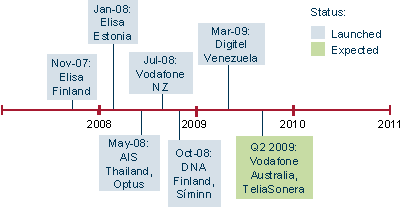| Рубрикатор |  |
 |
| Все новости |  |
World News |  |
 |
Breakthrough in Europe for UMTS900
| 15 мая 2009 |
On 24 March 2009, the European Parliament approved an amendment of the GSM Directive (87/372/EEC), which will allow UMTS systems (and in future other technologies) to be introduced in the 900MHz band.
This is a major breakthrough for the EU, where UMTS900 deployment has been held back pending the European Parliament’s long-awaited decision on liberalising the 900MHz band. While some national regulatory authorities (NRAs) had already allowed refarming or begun to consult on the future of the 900MHz band (for example, because the current GSM licences are due to expire), the regulatory bottleneck at EU level had deterred many NRAs from acting on spectrum refarming and therefore delayed operators in those countries from reaping the coverage and cost-saving benefits of deploying a UMTS network in this lower-frequency spectrum. The way is now cleared for NRAs throughout the region to introduce refarming measures, and for operators to realise the benefits that UMTS900 offers.
Cost-effective 3G coverage provision is the primary benefit of UMTS900, and this is especially important for large, sparsely populated land areas. The lower its frequency, the further a radio signal propagates (for a given transmitter power), which means that fewer sites are needed at 900MHz than at 2100MHz. This translates into indicative cost savings of around 50–70% for both network build and opex, and faster network roll-out. These benefits enable operators to roll out 3G services, such as mobile broadband, to suburban/rural areas that would be uneconomical to cover using UMTS2100, or, for GSM-only operators, to reduce the costs of building a new 3G network. Other benefits include potential improvements in indoor coverage and better voice quality, compared with GSM.
UMTS900 has already been demonstrated in a number of operational networks worldwide (see Figure 1), including those of DNA and Elisa in Finland, and we expect to see a wave of deployments from European operators over the next two years following the EU announcement.

Figure 1: UMTS900 network launches worldwide at April 2009 [Source: Analysys Mason, 2009]
Notwithstanding EU approval for UMTS900, operators in some countries will have to wait up to a year or possibly more before they can introduce the technology, depending on the extent of reorganisation of the 900MHz band that is needed prior to refarming and how quickly the NRAs and operators can agree and then implement a solution. Preparatory steps that may be required include:
-
reorganising the band into 5MHz blocks of paired spectrum, so that UMTS can be deployed in 5MHz carriers by all the operators in contiguous tranches
-
rebalancing operators’ spectrum holdings between the 900MHz and 1800MHz frequencies, if for historical reasons these have been assigned asymmetrically
-
setting aside a small amount of spectrum for auction to UMTS-only operators and/or a potential new entrant.
Particularly in countries where there are 3G operators without existing 900MHz spectrum holdings, there continue to be complex issues regarding the liberalisation of the 900MHz band, and these will take time to resolve.
If preparing the way for spectrum refarming is a lengthy process, then there will be a further consideration for both regulators and operators. The longer the preparatory steps take, the more advantageous it may become for operators to refarm their 900MHz spectrum to LTE rather than to UMTS. When UMTS900 was initially contemplated several years ago, LTE was still a long way from being a commercial reality, but this is no longer the case. Network equipment for LTE (for example eNodeB) will be available from vendors from 2009–2010 and, if there is demand from mobile operators to roll out LTE in rural areas for data coverage and the local regulatory framework is in place, the first LTE900 data devices could be on the market by 2010–2011. LTE offers a range of advantages over UMTS, including superior data rates and spectral efficiency, plus a smaller base station, improved power consumption and more flexible deployment. The GSM Amending Directive initially allows UMTS systems to be introduced in 900MHz spectrum, but other technologies such as LTE will also be permitted, once these can be demonstrated to co-exist satisfactorily with GSM. Particularly in countries that will be slow to implement refarming measures, operators should lobby their NRA to allow them to refarm their 900MHz spectrum directly to LTE if desired, rather than be restricted to introducing UMTS.
Catherine Viola, Senior Analyst
















Оставить свой комментарий:
Комментарии по материалу
Данный материал еще не комментировался.